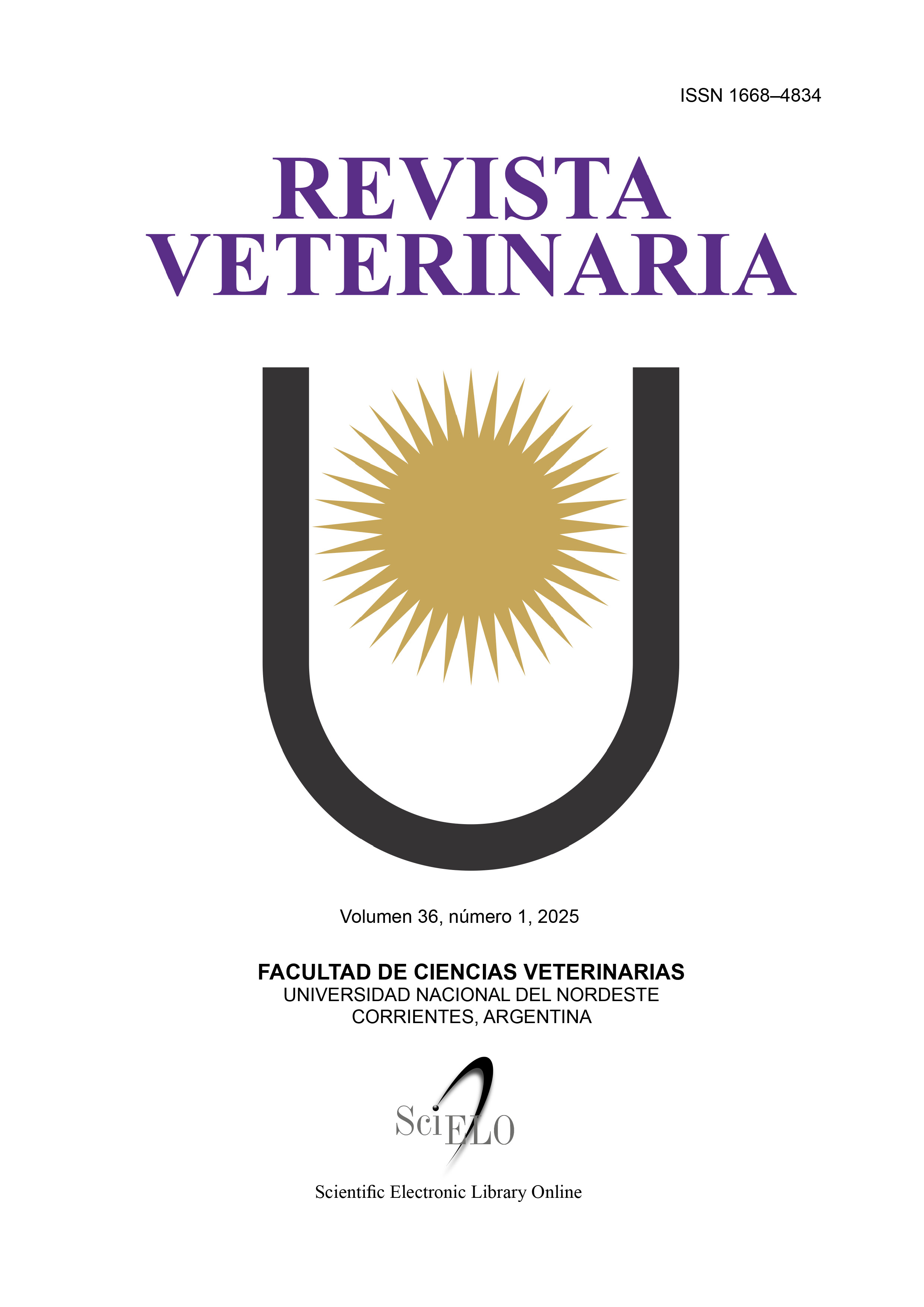Relación entre las características del fondo de extendido de moco cérvico-vaginal bovino y el estatus sanitario uterino
DOI:
https://doi.org/10.30972/vet.3618083Palabras clave:
moco cérvico-vaginal, salud uterina, bovinos, endometritis, extendidoResumen
El objetivo de este trabajo fue determinar si existe asociación entre el tipo de flujo, las características del fondo de los extendidos de moco cérvico-vaginal (MCV) y el estatus sanitario uterino. Se utilizaron 146 vacas Holando Argentino que se clasificaron en tres grupos, según examen ginecológico y lectura de cytobrush: grupo con endometritis clínica (EC), grupo con endometritis subclínica (ES) y grupo con estatus uterino sano (S). Para la lectura del fondo se colocó una gota de MCV sobre un portaobjetos, se dejó secar hasta que cristalizó y se observó a microscopio óptico. El fondo se clasificó en sucio (Su) o limpio (L) según la presencia o ausencia de detritus, células epiteliales e inflamatorias. El tipo de flujo normal se clasificó en transparente o turbio. Para el análisis estadístico de los datos se utilizó el software GraphPad® Prism5. Se aplicaron pruebas estadísticas paramétricas y no paramétricas, prueba de sensibilidad, prueba de especificidad, valor predictivo positivo, valor predictivo negativo y razón de verosimilitud. En el grupo sano el 85% de la lectura fue fondo tipo limpio y un 15% Su, grupo ES el 42% fondo limpio y 58% sucio, en el grupo EC 7% fondo tipo limpio y 93% sucio. La aplicación de la prueba de lectura de fondo de extendido como técnica diagnóstica presentó alta especificidad (93%) y sensibilidad (85%) para EC y alta especificidad (85%), baja sensibilidad (58%) para ES. Se encontró asociación entre los tipos de fondo y el estatus uterino, ya que el fondo sucio se asoció a muestras de MCV de vacas con endometritis y a un mayor porcentaje de polimorfonucleares neutrófilos en muestras de citologías endometrial. El flujo transparente se asoció con fondo limpio de extendido y el turbio con fondo sucio. En conclusión, la lectura del fondo de extendido de MCV es una técnica rápida, sencilla y económica que podría utilizarse a campo para evaluar las características de la salud uterina de la hembra.
Descargas
Citas
Abd-ElHafeez AM, Amin AMS, Ramadan MH, Helal A. y Mohamed M. The most applicable physical properties of cervical mucus correlated. Adv Anim Vet Sci. 2020; 8(s2): 122-31.
Abusineina M. A study of the fern-like crystalline patterns of the cervical and vaginal mucus of cattle. Vet Rec. 1962; 74(22): 619-21.
Adnane M, Meade KG, O’Farrelly C. Cervico-vaginal mucus (CVM) – an accessible source of immunologically informative biomolecules. Vet Res Commun. 2018a; 42(4): 255-63.
Adnane M, Kelly P, Chapwanya A, Meade KG, O’Farrelly C. Improved detection of biomarkers in cervico-vaginal mucus (CVM) from postpartum cattle. BMC Vet Res. 2018b; 14(1): 1-6.
Barnes M, Kasimanickam R, Kasimanickam V. Effect of subclinical endometritis and flunixin meglumine administration on pregnancy in embryo recipient beef cows. Theriogenology. 2023; 201: 76-82.
Bernardi SF, Savia CL, DE Paz LJ, Rodriguez J, Marini PR. Physical properties and ionic concentration of the bovine cervical mucus at the moment of inseminating: Spontaneous estrous and induced estrous. J Vet Sci Technol. 2018; 09(03): 2-5.
Bishnoi BL, Vyas KK, Dwaraknath, PK. Note on spinnbarkeit and crystallization pattern of bovine cervical mucus during oestrus. Indian J Anim Sci. 1982; 52(6): 438-40.
Brodzki P, Kostro K, Krakowski L, Marczuk J. Inflammatory cytokine and acute phase protein concentrations in the peripheral blood and uterine washings of cows with subclinical endometritis in the late postpartum period. Vet Res Commun. 2015; 39(2): 143-9.
Cheong SH, Nydam DV, Galvão KN, Crosier BM, Ricci A, Caixeta LS. Use of reagent test strips for diagnosis of endometritis in dairy cows. Theriogenology. 2012; 77(5): 858-64.
Cortés ME, Cabrera D, López R, Vigil P. Importancia del moco cervical en la fisiología reproductiva bovina. VI Congreso Internacional de Medicina Veterinaria y Zootecnia: artículos in extenso, Universidad Técnica de Cotopaxi Latacunga, Ecuador. 2016. p. 78-95.
Cortés ME, González F, Vigil P. Crystallization of Bovine Cervical Mucus at Oestrus: An Update. Rev Med Vet (Bogota). 2014; 28:103-16.
Denis-Robichaud J, Dubuc J. Determination of optimal diagnostic criteria for purulent vaginal discharge and cytological endometritis in dairy cows. J Dairy Sci. 2015; 98(10): 6848-55.
Drillich M, Tesfaye D, Rings F, Schellander K, Heuwieser W, Hoelker M. Effects of polymorphonuclear neutrophile infiltration into the endometrial environment on embryonic development in superovulated cows. Theriogenology. 2012; 77(3): 570-8.
Fernandez-Sanchez FI, Barrio-Lopez M, Quintela-Arias LA, Becerra-Gonzalez JJ, Peña-Martinez AI, Martinez-Bello D, Garcia-Herradon PJ, Perez-Marín, CC. Use of endometrial cytology and metabolic profiles for selection of embryo donor cows. Spanish J Agric Res. 2014; 12(3): 664-71.
Gilbert RO, Shin ST, Guard CL, Erb HN, Frajblat M. Prevalence of endometritis and its effects on reproductive performance of dairy cows. Theriogenology. 2005; 64(9): 1879-88.
Gilbert RO. Management of Reproductive Disease in Dairy Cows. Vet Clin North Am - Food Anim Pract. 2016; 32(2): 387-410.
Kasimanickam R, Duffield TF, Foster RA, Gartley CJ, Leslie KE, Walton JS, Johnson WH. Endometrial cytology and ultrasonography for the detection of subclinical endometritis in postpartum dairy cows. Theriogenology. 2004: 62(1-2): 9-23.
LeBlanc SJ. Postpartum uterine disease and dairy herd reproductive performance: A review. Vet J. 2008; 176(1): 102-14.
Lim HJ, Son JK, Yoon HB, Baek KS, Kim T il, Jung YS, Kwon EG. Physical Properties of Estrus Mucus in Relation to Conception Rates in Dairy Cattle. J Anim Reprod Biotechnol. 2014; 29(2): 157-61.
Machado VS, Knauer WA, Bicalho MLS, Oikonomou G, Gilbert RO, Bicalho RC. A novel diagnostic technique to determine uterine health of Holstein cows at 35 days postpartum. J Dairy Sci. 2012; 95(3): 1349-57.
Modi L, Suthar B, Nakhashi H, Sharma V, Panchasara H. Physical Characteristics of Estrual Cervical Mucus and conception rate in Repeat Breeder Kankrej Cattle. Int J Agro Vet Med Sci. 2011; 5(4): 416.
Quintela LA, Vigo M, Becerra JJ, Barrio M, Peña AI, Herradón, PG. Endometritis subclínica en ganado vacuno lechero: etiopatogenia y diagnóstico. Revisión Bibliográfica. ITEA, Información Técnica Económica Agraria: Revista de La Asociación Interprofesional Para El Desarrollo Agrario (AIDA). 2017; 113(3): 250-266.
Rinaudo A, Bernardi SF, Marini PR. Prevalencia de endometritis clínica y subclinica en vacas lechera en postparto en un sistema intensivo estabulado. Rev FAVE. 2011; 10(2): 59-66.
Runciman DJ, Anderson GA, Malmo J. Comparison of two methods of detecting purulent vaginal discharge in postpartum dairy cows and effect of intrauterine cephapirin on reproductive performance. Aust Vet J. 2009; 87(9): 369-78.
Savia CL, Reátegui J, Marini PR. Relación entre características físicas y contenido iónico del moco cervical con el estado de preñez al inseminar vaquillonas a celo detectado. Spermova. 2016; 6(2): 153-8.
Savia CL, Osorio JS, Rodríguez JV, Guibert EE, Rinaudo A. A simple and reliable refractometric method to determine the total solids concentration of the cervico-vaginal bovine mucus samples. Heliyon. 2021; 7(5): 1-6.
Savia CL. Características físico-químicas del moco cérvico-vaginal de vacas Lecheras Holando Argentino con endometritis subclínica. Tesis doctoral, Universidad Nacional de Rosario, Casilda, Argentina. 2023.
Sheldon IM, Cronin JG, Bromfield JJ. Tolerance and innate immunity shape the development of postpartum uterine disease and the impact of endometritis in dairy cattle. Annu Rev Anim Biosci. 2019; 7(1): 361-384.
Tsiligianni TH, Karagiannidis A, Brikas P, Saratsis PH. Relationship between certain physical properties of cervical mucus and fertility in cows. Dtsch Tierarztl Wochenschr. 2000; 107(1): 28-31.
Tsiligianni T, Karagiannidis A, Brikas P, Saratsis P. Physical properties of bovine cervical mucus during normal and induced (progesterone and/or PGF2α) estrus. Theriogenology. 2001; 55(2): 629-40.
Van Raemdonck GAA, Tjalma WAA, Coen EP, Depuydt CE, Van Ostade XWM. Identification of protein biomarkers for cervical cancer using human cervicovaginal fluid. PLoS One. 2014; 9(9): e106488.
Van Schyndel SJ, Pascottini OB, Leblanc SJ. Comparison of cow-side diagnostic techniques for subclinical endometritis in dairy cows. Theriogenology. 2018; 120: 117-122.
Villacrés Barrionuevo VM. Diagnóstico de endometritis subclínica mediante citobrush en vacas post-parto en el hato del CIPCA. BS thesis. Universidad Estatal Amazónica, Puyo, Ecuador. 2016.
Zegels G, Van Raemdonck GAA, Tjalma WAA, Van Ostade XWM. Use of cervicovaginal fluid for the identification of biomarkers for pathologies of the female genital tract. Proteome Sci. 2010; 8: 1-23.
Descargas
Publicado
Cómo citar
Número
Sección
Licencia

Esta obra está bajo una licencia internacional Creative Commons Atribución-NoComercial 4.0.
Política de acceso abierto
Esta revista proporciona un acceso abierto inmediato a su contenido, basado en el principio de que ofrecer al público un acceso libre a las investigaciones ayuda a un mayor intercambio global de conocimiento. La publicación por parte de terceros será autorizada por Revista Veterinaria toda vez que se la reconozca debidamente y en forma explícita como lugar de publicación del original.
Esta obra está bajo una licencia de Creative Commons Reconocimiento-NoComercial 4.0 Internacional (CC BY-NC 4.0)










.jpg)
.jpg)



